| Miles Davis: "Kind
Of Blue" (Columbia, Mai 1959) |
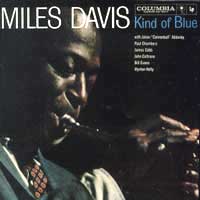 Einer der Jazzklassiker schlechthin. Und da es gerade eine aktuelle (und
preisgünstige!) Wiederveröffentlichung gibt, fand das Album
auch den Weg in Rainers Inselplatten-Liste!
Einer der Jazzklassiker schlechthin. Und da es gerade eine aktuelle (und
preisgünstige!) Wiederveröffentlichung gibt, fand das Album
auch den Weg in Rainers Inselplatten-Liste!
|
| Chet Baker: "Chet"
(Riverside, 1959) |
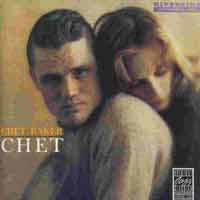

 Mehr ...
Mehr ...
The file texte/ChetBaker-Chet.htm does not exist
|
| Art Blakey And The Jazz Messengers: "Moanin'"
(Blue Note, 1959) |
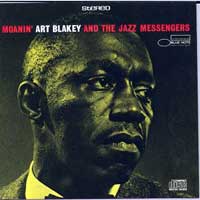 Aufgenommen 1956, erschienen aber wohl erst 1959. Enthält mit dem Titelsong
aus der Feder von Pianist Bobby Timmons und "Along Came
Betty" von Saxofonist Benny Golson gleich zwei Originalaufnahmen
zukünftiger Jazzklassiker. An der Trompete überzeugt Lee Morgan.
Aufgenommen 1956, erschienen aber wohl erst 1959. Enthält mit dem Titelsong
aus der Feder von Pianist Bobby Timmons und "Along Came
Betty" von Saxofonist Benny Golson gleich zwei Originalaufnahmen
zukünftiger Jazzklassiker. An der Trompete überzeugt Lee Morgan.
(10.03.2009)

 Mehr ...
Mehr ...
Das ist wahrlich einer der großen Klassiker des Hardbop: Art Blakey führt seine wohl beste Jazz-Messengers-Besetzung durch ein treibendes Programm, das keinen Moment nachlässt. Tenorsaxophonist Benny Golson (dessen in der Folge zum Jazzklassiker gewordenes "Along Came Betty" hier zum ersten Mal zu hören ist), der brillante Trompeter Lee Morgan und der funky Pianist Bobby Timmons, der den Titelhit schrieb, spielen einige der besten Solos ihrer gro&ßen Karrieren, und Blakey selbst war niemals besser. Diese CD sollte in keiner Jazzsammlung fehlen. Sie bleibt einer der führenden Posten im Blue Note-Katalog und das mit Recht. Im Rahmen der 60-Jahr-Feier des Blue-Note-Labels 1999 hat Rudy Van Gelder, der Produzent der Originalaufnahme, einen Bombenjob mit dem Remix von "Moanin'" abgeliefert: Die Bässe sind wärmer geworden, das Gesamtspektrum farbiger. Das Booklet mit den alten Schwarzweiss-Fotos der Session ist wie ein LP-Klappcover zu öffnen.
(Skip Heller, aus der Amazon.de-Redaktion)
Renowned for his powerful, energetic style, Pittsburgh drummer Art Blakey had been leading The Jazz Messengers for five years when they released Moanin’, arguably the group’s definitive recording. Due to the many young, up-and-coming musicians that passed through the group’s ranks during its long history (1954-1990), the band was dubbed the “Hard Bop Academy”, and on Moanin’ Blakey’s new recruits included Philadelphia pianist Bobby Timmons, who wrote the album’s gospel-flavoured title tune, often cited as a quintessential example of the Blue Note sound. Also fresh in from Philly was tenor saxophonist Benny Golson, who composed three of the album’s other highlights – ‘Along Came Betty’, ‘The Drum Thunder Suite’ (a vehicle for Blakey’s polyrhythmic percussion prowess) and ‘Blues March’ – while teenage trumpet sensation Lee Morgan shone throughout with his precocious virtuosity. Though regarded as an archetypal hard bop session, the album’s title song, with its sanctified call-and-response cadences, anticipated the more immediate soul jazz style of the early 60s. Francis Wolff’s stark cover portrait of Blakey caps what is one of the greatest albums in Blue Note’s repertoire – one that no guide to Blue Note can be without.
(www.udiscovermusic.com)
|
| Ornette Coleman: "The Shape
Of Jazz To Come" (Atlantic, 1959) |
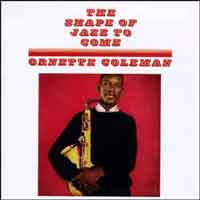 Der Titel sagt's schon: der Jazz, der bald kommen wird. Zwar noch kein
"Freejazz", wie wir ihn heute kennen (und der mir meist zu anstrengend
ist), aber die Musik lässt schon so manches erahnen. Die ideale Platte
für Neueinsteiger in die Musik einer der wichtigsten Jazzmusiker
aller Zeiten.
Der Titel sagt's schon: der Jazz, der bald kommen wird. Zwar noch kein
"Freejazz", wie wir ihn heute kennen (und der mir meist zu anstrengend
ist), aber die Musik lässt schon so manches erahnen. Die ideale Platte
für Neueinsteiger in die Musik einer der wichtigsten Jazzmusiker
aller Zeiten.

 Mehr ...
Mehr ...
|
Ornette Coleman's Atlantic debut, The Shape of Jazz to Come, was a watershed
event in the genesis of avant-garde jazz, profoundly steering its future
course and throwing down a gauntlet that some still haven't come to grips
with. The record shattered traditional concepts of harmony in jazz, getting
rid of not only the piano player but the whole idea of concretely outlined
chord changes. The pieces here follow almost no predetermined harmonic
structure, which allows Coleman and partner Don Cherry an unprecedented
freedom to take the melodies of their solo lines wherever they felt like
going in the moment, regardless of what the piece's tonal center had seemed
to be. Plus, this was the first time Coleman recorded with a rhythm section
-- bassist Charlie Haden and drummer Billy Higgins -- that was loose and
open-eared enough to follow his already controversial conception. Coleman's
ideals of freedom in jazz made him a feared radical in some quarters;
there was much carping about his music flying off in all directions, with
little direct relation to the original theme statements. If only those
critics could have known how far out things would get in just a few short
years; in hindsight, it's hard to see just what the fuss was about, since
this is an accessible, frequently swinging record. It's true that Coleman's
piercing, wailing alto squeals and vocalized effects weren't much beholden
to conventional technique, and that his themes often followed unpredictable
courses, and that the group's improvisations were very free-associative.
But at this point, Coleman's desire for freedom was directly related to
his sense of melody -- which was free-flowing, yes, but still very melodic.
Of the individual pieces, the haunting "Lonely Woman" is a stone-cold
classic, and "Congeniality" and "Peace" aren't far
behind. Any understanding of jazz's avant-garde should begin here.
(by Steve Huey , AMG) |
|
| Joao Gilberto: "Chega De Saudade"
(Odeon, 1959) |
 Brazil! Brazil!
(24.03.2013) |
| Charles Mingus: "Mingus
Ah Um" (Columbia, 1959) |
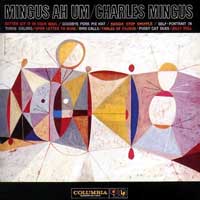 Das Album mit den Hits "Good Bye Pork Pie Hat" und "Better
Git It In Your Soul".
Das Album mit den Hits "Good Bye Pork Pie Hat" und "Better
Git It In Your Soul".

 Mehr ...
Mehr ...
| "Charles Mingus – Ein Meisterkomponist des 20.
Jahrhunderts. Ein ganz Großer. Unter mindestens 15 richtigen Top-Alben
ist dies, neben „The
Black Saint & The Sinner Lady“, sein Bestes. „Eingängig“
ist wohl das falsche Wort, aber verblüffend leicht zugänglich
ist diese Musik, gespickt mit lauter wahrhaftig wunderbaren Melodien, manche
gehören zu den schönsten im ganzen Jazz. Noch dazu sind sie eingebettet
in Weltklasse-Arrangements, phantasievoll, einfallsreich, schillernd, anspruchsvoll
(obwohl es doch so selbstverständlich klingt...). Hier kommen Intelligenz,
große Gefühle, brillante Instrumentalarbeit, traumwandlerische
musikalische Kommunikation und sogar Humor zusammen. Die Grundstimmung reicht
von aggressiv bzw. sehr schnell bis zu sophisticated bzw. relaxt. Als Ganzes
geschlossen, und jedes Stück als einzelnes großartig, wobei 3
Tracks nochmal herausragen, wahre Jahrhundertsongs: Better git it in your
soul, Goodbye pork pie hat, Fables of Faubus. Der Stil? Wie wär´s
mit „Hard und BeBop meets Ellington“? Aber eigentlich...eine eigene
Kategorie. Aufgenommen 1959 im Septet. mit 4 Bläsern." (Glitterhouse) |
|
| Charles Mingus' debut for Columbia, Mingus Ah Um is a stunning
summation of the bassist's talents and probably the best reference point
for beginners. While there's also a strong case for The Black Saint and
the Sinner Lady as his best work overall, it lacks Ah Um's immediate acccessibility
and brilliantly sculpted individual tunes. Mingus' compositions and arrangements
were always extremely focused, assimilating individual spontaneity into
a firm consistency of mood, and that approach reaches an ultra-tight zenith
on Mingus Ah Um. The band includes longtime Mingus stalwarts already well
versed in his music, like saxophonists John Handy, Shafi Hadi, and Booker
Ervin, trombonists Jimmy Knepper and Willie Dennis, pianist Horace Parlan,
and drummer Dannie Richmond. Their razor-sharp performances tie together
what may well be Mingus' greatest, most emotionally varied set of compositions.
At least three became instant classics, starting with the irrepressible
spiritual exuberance of signature tune "Better Get Hit in Yo' Soul,"
taken in a hard-charging 6/8 and punctuated by joyous gospel shouts. "Goodbye
Pork Pie Hat" is a slow, graceful elegy for Lester Young, who died
not long before the sessions. The sharply contrasting "Fables of Faubus"
is a savage mockery of segregationist Arkansas governor Orval Faubus, portrayed
musically as a bumbling vaudeville clown (the scathing lyrics, censored
by skittish executives, can be heard on Charles Mingus Presents Charles
Mingus). The underrated "Boogie Stop Shuffle" is bursting with
aggressive swing, and elsewhere there are tributes to Mingus' three most
revered influences: "Open Letter to Duke" is a suite of three
tunes; "Bird Calls" is inspired by Charlie Parker; and "Jelly
Roll" is an idiosyncratic yet affectionate nod to jazz's first great
composer, Jelly Roll Morton. It simply isn't possible to single out one
Mingus album as definitive, but Mingus Ah Um comes the closest. -- Steve
Huey (AMG) |
|
 Einer der Jazzklassiker schlechthin. Und da es gerade eine aktuelle (und
preisgünstige!) Wiederveröffentlichung gibt, fand das Album
auch den Weg in Rainers Inselplatten-Liste!
Einer der Jazzklassiker schlechthin. Und da es gerade eine aktuelle (und
preisgünstige!) Wiederveröffentlichung gibt, fand das Album
auch den Weg in Rainers Inselplatten-Liste!

 Mehr ...
Mehr ...
 Aufgenommen 1956, erschienen aber wohl erst 1959. Enthält mit dem Titelsong
aus der Feder von Pianist Bobby Timmons und "Along Came
Betty" von Saxofonist Benny Golson gleich zwei Originalaufnahmen
zukünftiger Jazzklassiker. An der Trompete überzeugt Lee Morgan.
Aufgenommen 1956, erschienen aber wohl erst 1959. Enthält mit dem Titelsong
aus der Feder von Pianist Bobby Timmons und "Along Came
Betty" von Saxofonist Benny Golson gleich zwei Originalaufnahmen
zukünftiger Jazzklassiker. An der Trompete überzeugt Lee Morgan. Mehr ...
Mehr ...
 Der Titel sagt's schon: der Jazz, der bald kommen wird. Zwar noch kein
"Freejazz", wie wir ihn heute kennen (und der mir meist zu anstrengend
ist), aber die Musik lässt schon so manches erahnen. Die ideale Platte
für Neueinsteiger in die Musik einer der wichtigsten Jazzmusiker
aller Zeiten.
Der Titel sagt's schon: der Jazz, der bald kommen wird. Zwar noch kein
"Freejazz", wie wir ihn heute kennen (und der mir meist zu anstrengend
ist), aber die Musik lässt schon so manches erahnen. Die ideale Platte
für Neueinsteiger in die Musik einer der wichtigsten Jazzmusiker
aller Zeiten.
 Mehr ...
Mehr ...
 Brazil!
Brazil! Das Album mit den Hits "Good Bye Pork Pie Hat" und "Better
Git It In Your Soul".
Das Album mit den Hits "Good Bye Pork Pie Hat" und "Better
Git It In Your Soul".
 Mehr ...
Mehr ...
